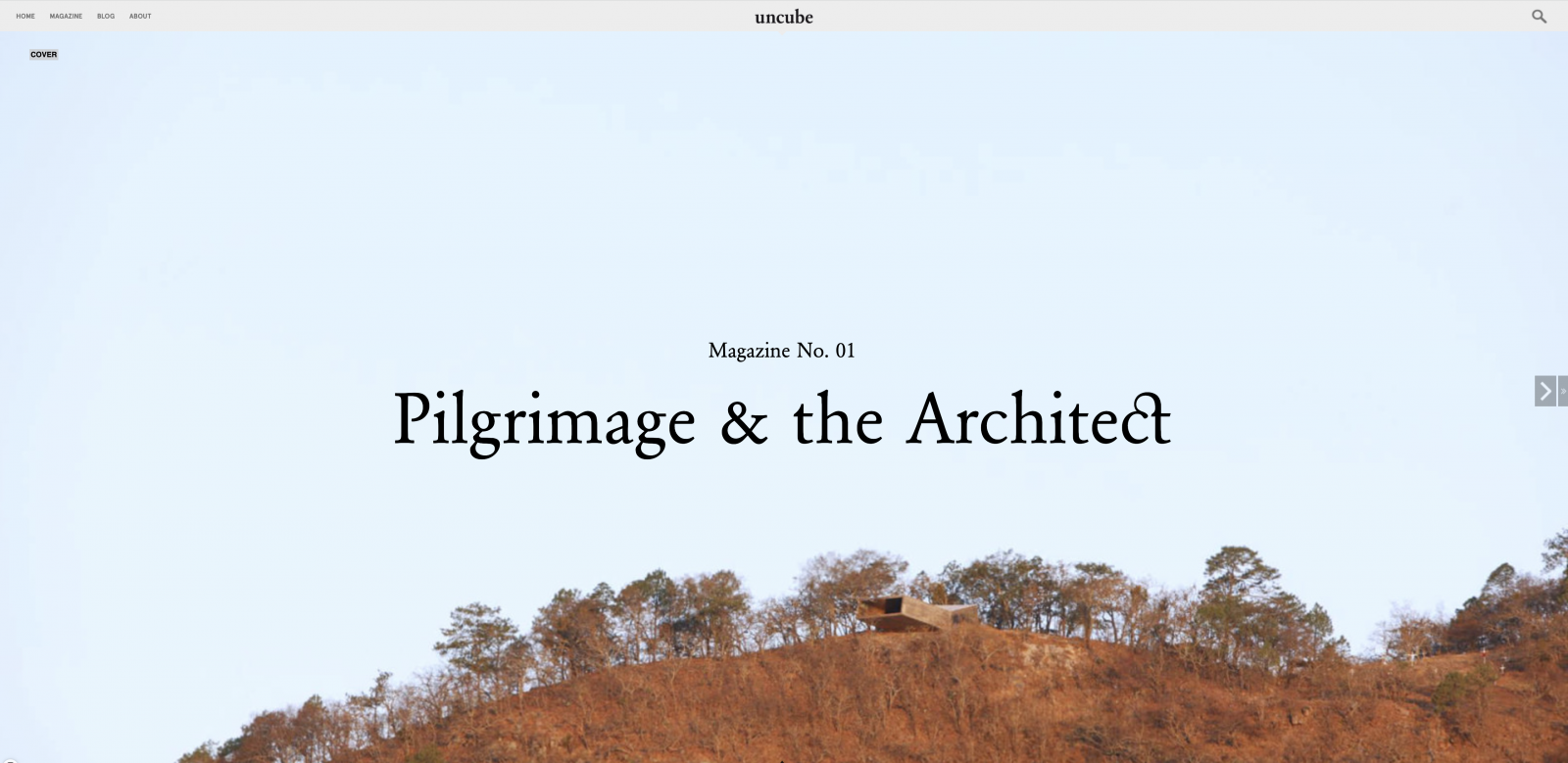“uncube”. Architecture Between Paper and Digital, and Beyond
An Interview with Sophie Lovell
by Michela Maguolo
English abstract
In August 2012, BauNetz, Germany’s largest online architecture portal, launched their first international publication: a digital architecture magazine in English called “uncube”. The magazine, they claimed, would combine paper and digital virtues by design in the form of a monthly themed journal together with a weekly newsletter and more frequent blog posts. “uncube”, they hoped, where the cube, BauNetz’s trademark, could be opened up and allow its contents mix with the world. Founded in 1996, BauNetz had grown over the years into a comprehensive German-language portal for the building industry with various platforms for finding information about new buildings, construction techniques and solutions, design and construction products, events, conferences, courses, and even jobs. “uncube” magazine was their bid to reach a global English-speaking market with an out-of-the-box format. Like many digital platforms, its constant flow of data, news and images followed a rhythm dictated by daily updates, the exploration of which can take place from any point and in any direction through searching and vertical scrolling. “uncube”, conversely, was conceived like a typical magazine, with themed issues to be browsed from the first to the last page horizontally. Its digital side consisted of an integrated reader function, and an advanced content management system that allowed each issue to be produced in the interaction between editorial, design and programming. Each issue was devoted to a particular topic – a concept or a social issue, a protagonist in architecture, a place, or a material – which was then investigated through texts, interviews, images, video, and audio clips. “uncube” quickly gained a rapidly growing global following of fans, not just amongst architects, and received numerous awards. Nevertheless, after 43 issues and at the height of its popularity, the publication ceased in April 2016.
Sophie Lovell, former Editor-in-chief of “uncube”, agreed to answer a few questions and explain the aims and motives, ideas and concepts that have defined the magazine’s identity.
Michela Maguolo | For those who have followed “uncube” since its inception, the announcement on 12th April 2016 that issue no. 43 was the last one and “uncube” was ending its publication was something of a shock, because “uncube” was the first unconventional digital window opened on the world of “architecture and beyond”. My first question is about the reasons and goals you had in mind when you founded “uncube”, what idea of architecture you wanted to communicate: what was that “beyond” about?
Sophie Lovell | That is nice of you to say so! It amazes me how, five years after we ended the magazine, people still come up to me and tell me how much they loved “uncube”. We must have been doing something right. “uncube” was founded by the German digital architecture platform BauNetz in 2012 and I did not join the team as editor-in-chief until Summer 2013. My previous job had been as executive editor of the oldest German design magazine “form” which was very much still stuck in a traditional print format, so I was excited to be switching to the other extreme of pure digital publishing. I interpreted the magazine’s “architecture and beyond” strapline to mean contextual connections in all directions. No one needed another architecture publication that said: “Look! Another new building!”. What was needed, in my view, was some big-picture thinking about the complex systems architecture is embedded in, yet no one seemed to be talking about. Not to mention this giant interdisciplinary shift in approach that was already underway. For the first few issues after I arrived, our publisher kept asking “But where are the buildings? Where is the architecture?” And I kept saying: “Don’t worry, I know what I’m doing”. All I really knew was that I was steering into uncharted waters, but it felt like the right thing to do.
MM | How was each issue designed? Was the choice of the theme decided by the editorial staff or was there a guest editor as in many magazines nowadays?
SL | The template for “uncube” was designed as a digital magazine to be “like print, but without the paper” by the Berlin-based design studio Henkel Hiedl. It was way ahead of its time with its horizontal navigation and still looks pretty good even now. That’s not something you can usually say about digital design that is 10 years old. Our graphic design team then kept modifying it to meet the demands of each issue. I remember issue no. 19, Space (as in Outer Space), to be particularly challenging: we added gifs and sound loops, slides, montages, and new title formats. We drove the programmers nuts. In terms of concepting, every Tuesday me and the editorial and design team (about eight of us including interns) took it in turns to cook lunch and then eat together at our huge conference table. It was over those epic meals that we thrashed out themes and gathered interesting story clusters we had come across. The themes decided themselves in a way. They were ideas that wanted to be expressed: Zeitgeist and all that. We had a guest editor once, Francesca Ferguson edited the Urban Commons issue in 2014. But the rest we decided to do ourselves. We would decide on the issue themes a few months in advance and then different editors would be in charge of collecting the initial material for different topics, but it really was a group effort. Everyone pitched in and was allowed their say. I think that was the secret of our contextual approach. The team came from all sorts of backgrounds: design, biology, philosophy, politics… (architects were actually in the minority) and they brought all their different perspectives with them into the magazine. I may have been the one who made the final choices in the end, but there were plenty of times I was persuaded to change my mind and rightly so.
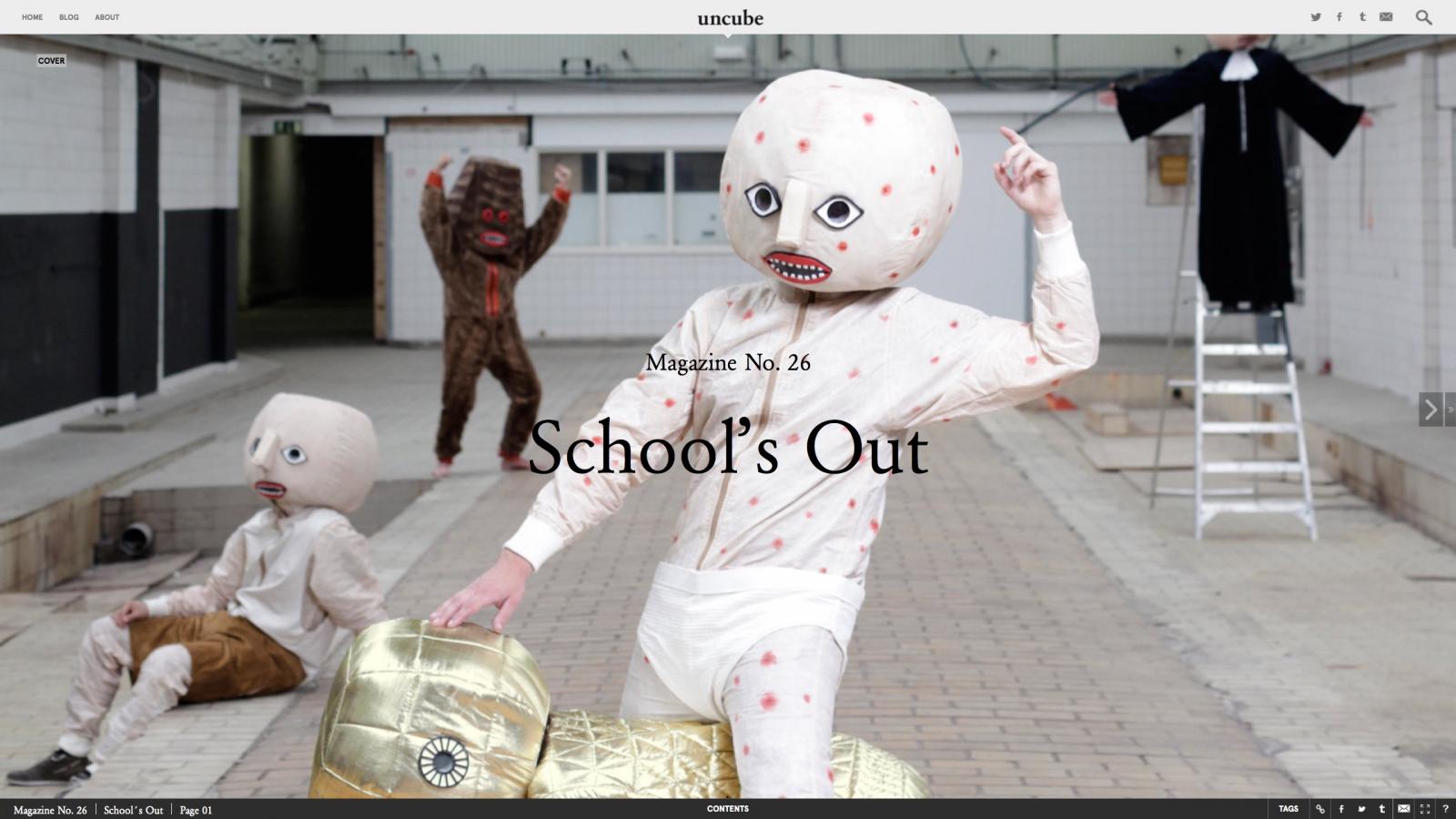
MM | Some of the themes were particularly unconventional, like Veins, Carbon, Thank You, I’ll Do It Myself, sometimes inconvenient, like Urban Commons or School’s Out, for an architecture magazine. Can you explain the aims of such choices and whether you think that a magazine should be provocative?
SL | Haha! I did not set out to be provocative at all. I just thought: these are great topics that need to be addressed and this is what I want to read about. I made exactly the magazine I had always wanted to make. And it happened to have architecture as its core theme. I don’t think people generally realize they are being avant-garde when they are in the process. You are too busy being caught up in the passion of creation. It was only much later and more recently when we began seeing people picking up on our themes and making publications, books, exhibitions, conferences, teaching modules and so on out of them that we started to realize how incredibly ahead of our time we were. I think some of my favourites were Uncanny Valley, Soft Machines, Storage and also After Dark. I think, strangely, one of the most provocative issues we did was Zaha. With her parametric designs, the Qatar stadium controversy, etc. Zaha Hadid was not an obvious choice. The reason we did the issue was because the whole team reacted so strongly against the idea when it was suggested, which perversely made us realize that that was exactly the right reason to do it. And I am so glad we did. I have so much more respect for her now. Architecture was and is a horrifically misogynistic, white male profession. As an Iraqi woman, being brilliant was not enough. She had to create a persona and play the really long game to get recognition and her work built. We were so shocked when she died suddenly shortly after the issue was published. Suddenly the “uncube”’s zeitgeist seemed a bit too scarily on point. I think my interview with her for it may have been one of the last ones she gave.
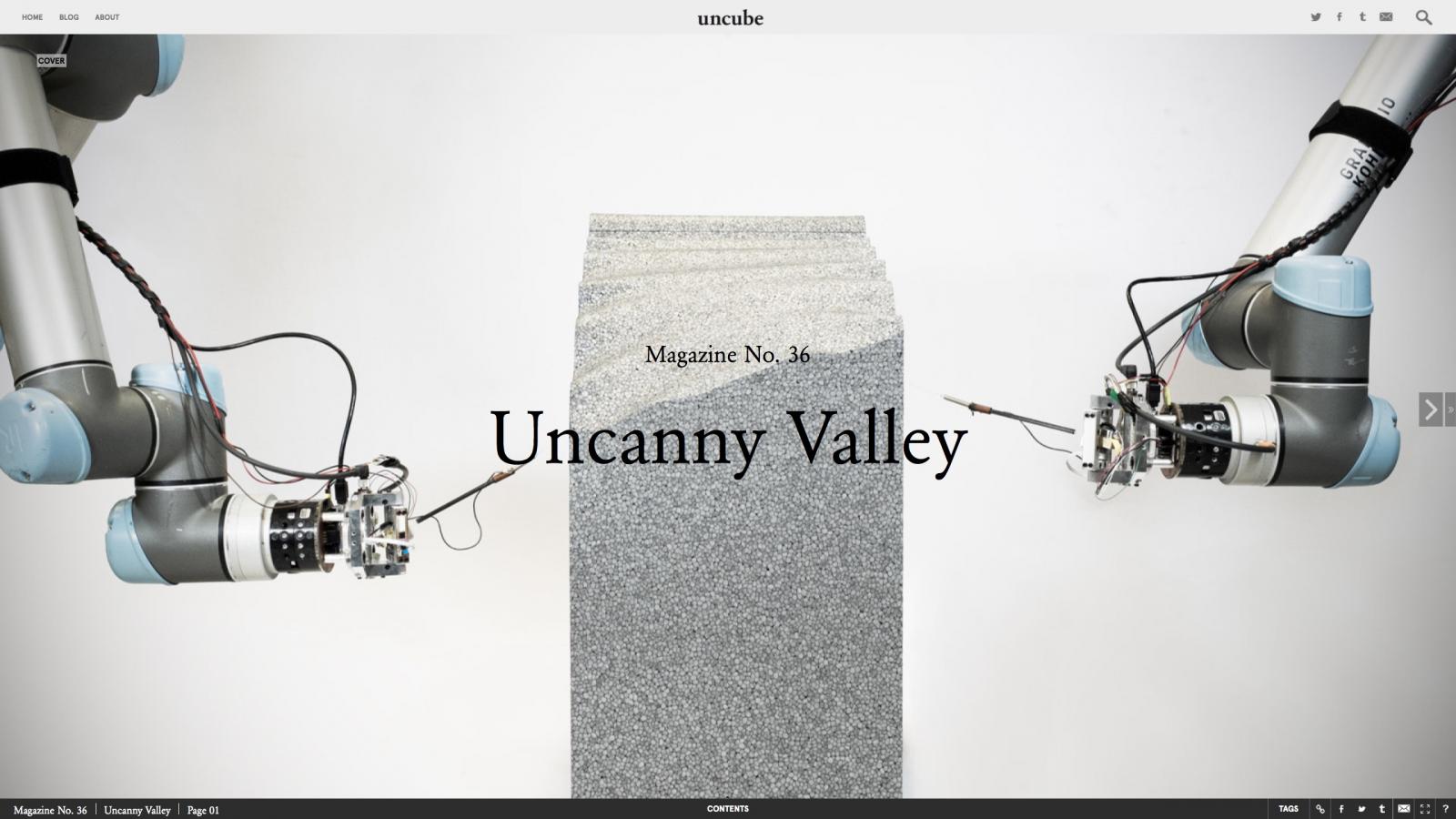
MM | Beatriz Colomina and Craig Buckley, editors of Clip Stamp, Fold. The radical architecture of little magazines 196X to 197X observed that “just as experimental little magazines drove the historical avant-garde in the 1920s, the 1960s saw a rebirth and transformation of the little magazines that launched a whole spectrum of radical practices.” Can “uncube” be considered a little magazine of the digital era?
SL | Oh wow. I would be completely honoured and proud for “uncube” to be considered in that context. But maybe, modesty aside and with hindsight, yes, it can. The advantage that the digital brings is that the magazine is still online and people still read it. Between five and eight years after we made some of these issues, people are still finding them, wanting to read them and learn from them.
MM | In the mission statement you declare that “uncube” was conceived in a format that combines the virtues of print with the convenience of the digital. Do you think that architectural communication has changed and if so, how, with the digital?
SL | I think English-language architectural communication has been massively impoverished in recent years, just at the time when new thinking and new information is needed most. Both digitally and in print. It distresses me that no architecture publication seems to have taken up “uncube”’s role. The couple of digital big players still around are mainly just glorified press releases and clickbait. Most of the others are so niche and inaccessible – either behind paywalls or walls of dense academic-speak that are exclusive in different ways. The rest are so hamstrung by budget cuts and lack of investment that their poor overworked staff have little capacity to develop their editorial voice anymore. I would be curious to know what the situation is in other languages. How is it in Italy, for example?
MM | Have you ever envisaged a paper version of the magazine (apart from the downloadable pdf of the first two issues)? And do you think that both digital and paper formats can work together for an architecture magazine?
SL | One of the most common questions I was asked as editor of “uncube” was: “Print or digital, which is best?”. My answer was and is: “That’s the wrong question.” Both of course. They can work separately and together, with all sorts of variations in between – like podcasts, “reels” or “stories”. Having said that, we never wanted a print version of “uncube”. Professors used to mail us asking for pdfs of a particular issue because they wanted to give it to their students for their reading lists, which made us laugh. We had to write back and say: “Just give them the link!” We did want to make a really rough riso-printed zine to accompany the Walk the Line drawing issue no. 42, but at that stage, we already knew that “uncube” was being stopped and it didn’t happen sadly.
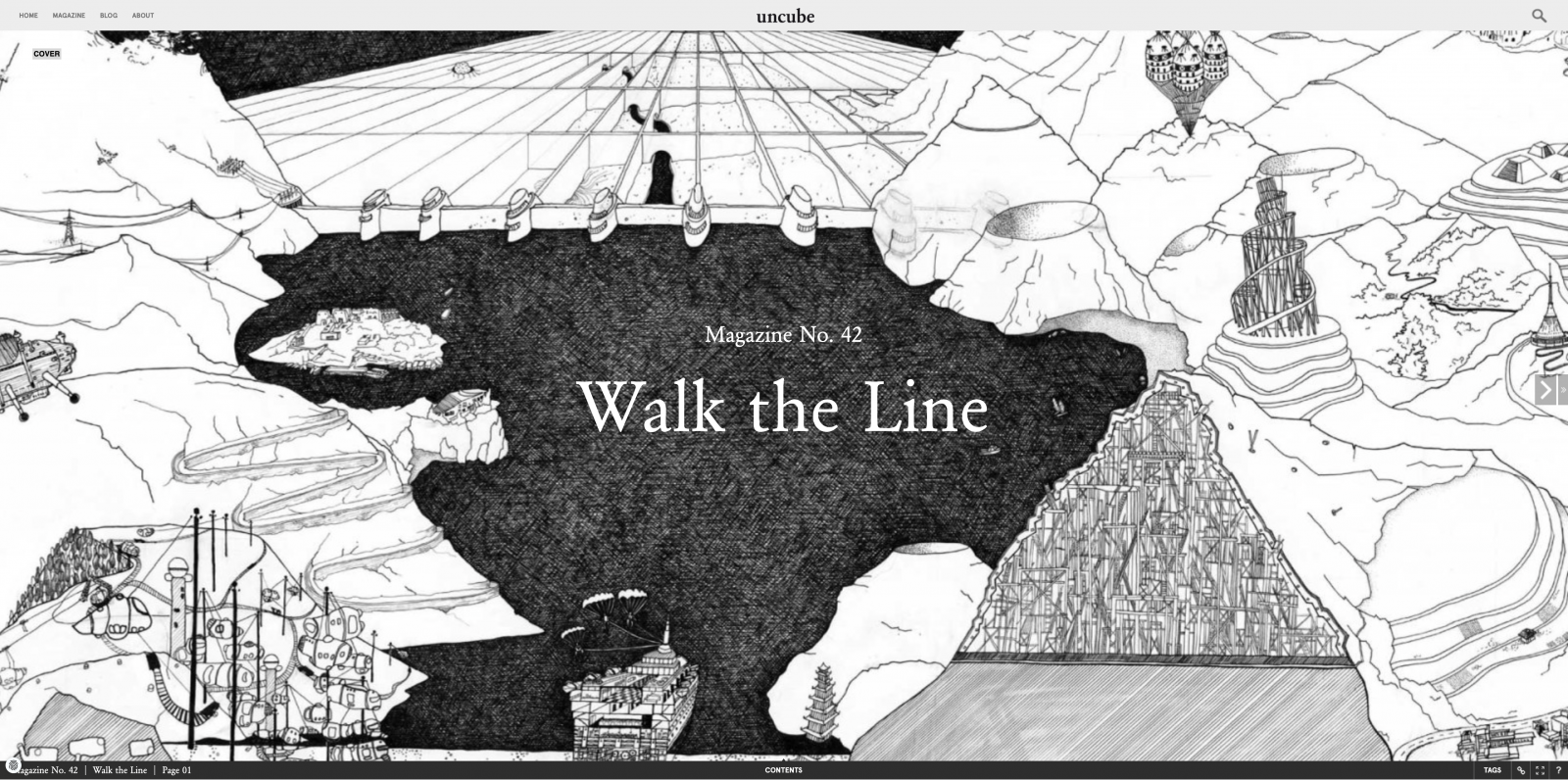
MM | “Mission accomplished” was the heading of the last newsletter: what was the stock-taking then and what were the reasons for discontinuing the magazine so abruptly – if the decision was a sudden one?
SL: It was sudden and a shock for our readers but not for us. We knew about three months before the magazine folded that the owners were going to stop it, but we were told not to tell anyone because the parent company was in the process of being sold. The decision to end “uncube” was, as far as I understood it, the result of a combination of internal politics, a parent company that was owned by investors rather than real people, and a lack of understanding of the potential of the “uncube” digital platform to be anything other than an outdated “magazine” format funded by advertising. This inability to adapt and understand shifts in potential or consider “value” in terms other than those of the spreadsheet is quite a universal story that has marked the demise of so much great publishing in the last 20 years sadly.
MM | So what happened next?
SL | After “uncube” folded in Spring 2016, the editorial and graphics team stayed together and formed a collective called &beyond collective. As a team, we designed, produced and edited a six-volume print and digital book series called “Archifutures” for the Future Architecture Platform that was published by dpr barcelona. The “Archifutures” series continued the “uncube” thinking in their themes and holistic approach with titles like Thresholds (2017), Apocalypse (2018) and Agency (2020), focusing on new narratives and strategies from emerging practitioners. We also did a print and digital series with podcast elements called “Sonic Urbanism” for “Theatrum Mundi”, the most recent of which “Listening to Non-human Life” was published in January 2022. When “uncube” ended, all the messages of shock and sadness from our readership all over the world really moved us a lot as a team. It was totally unexpected, but it also showed us that we had achieved what we had set out to do: to understand and share architecture stories in context and in a way that non-architects could also enjoy and learn from. “uncube” died a rock ‘n’ roll cliché death: young and beautiful, before its time, without selling out or compromise. I will always be proud as hell of it.
MM | Do architecture magazines still make sense?
SL | That’s a good question. I think I can answer best from a personal point of view. I began my writing career writing about art. But sometime in the 1990s, I felt that “art” was not addressing the issues I felt it should be addressed in an inspiring or thought-provoking enough way. I would go to exhibitions and find that the work being done by architects and designers was fulfilling that role instead. So, I shifted to writing about design and architecture. In the last couple of years, I have had a similar epiphany. At the beginning of 2021, together with my daughter, the food designer Orlando Lovell, I founded a new digital publishing entity called The Common Table as a platform for food futures and systemic change. For me, this is a direct descendant of “uncube” with the same kind of holistic thinking. It just happens to be centred on food. Architecture is nothing if not sets of complex systems related to quality of human life. The same is true for what is inappropriately called the food chain. When we talk about food, it is not just science, it is not just storytelling, it is not just design, art, business or politics, it’s all of those things and more – together and interconnected – and so needs to be approached in an interdisciplinary way. That’s exactly how I feel about architecture. The struggle to shift from extractive economies and practices towards communal regenerative responsibility is universal and it is complex. In order to share constructive examples and stories of practice, and therefore potential for agency, we need to find vocabularies that can reach people and are understandable. That is what publishing is about. And that is what we are trying to do. Do architecture magazines still make sense? Yes, if you think about them in this way and therefore understand that The Common Table is on its way to being another really excellent architecture magazine and that, like “uncube”, they does not have to be about buildings to be relevant to architecture.
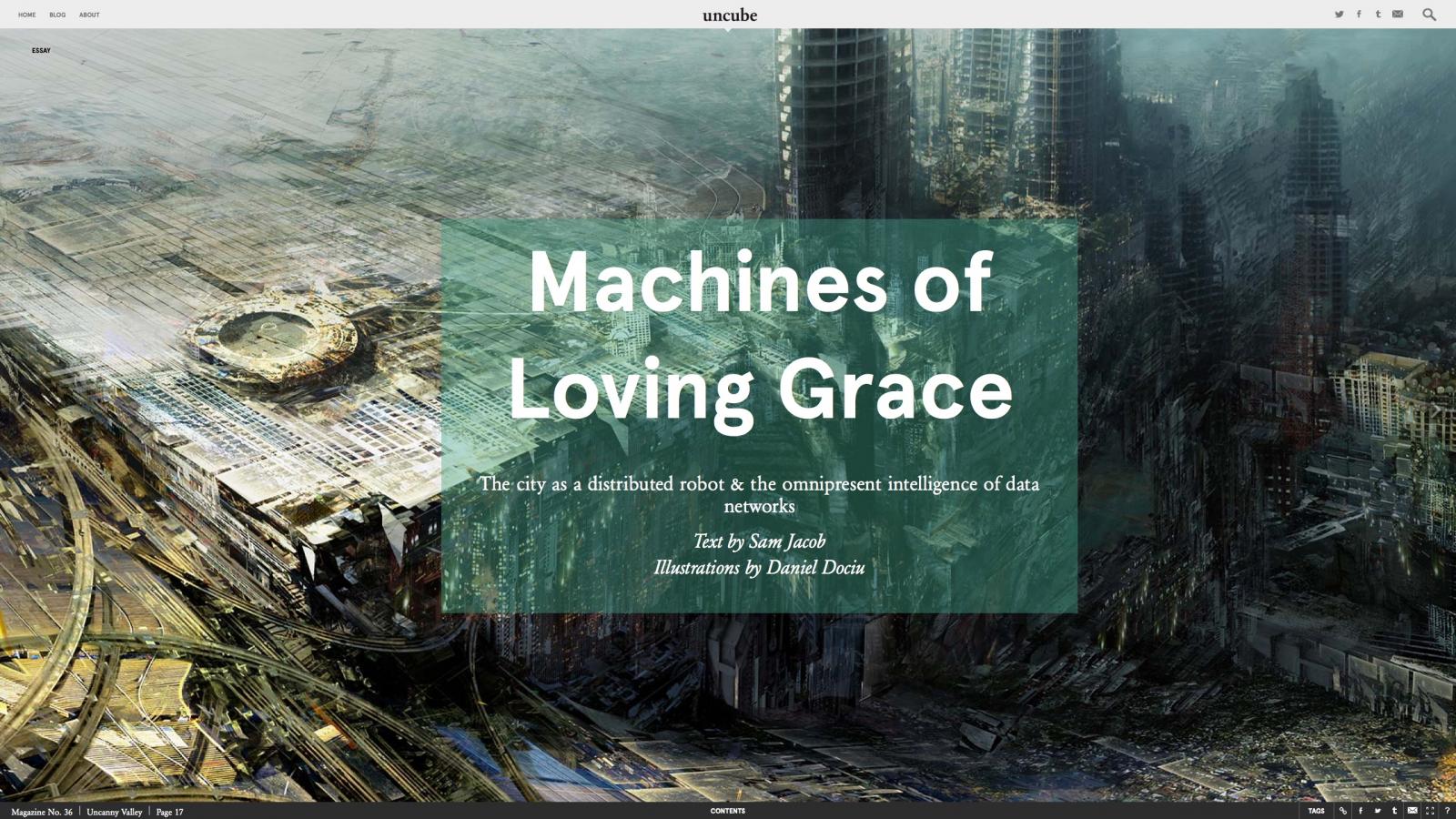
Machines of Loving Grace, from “uncube” 36, “Uncanny Valley” (September 2015) .
English abstract
In this interview, Sophie Lovell, former Editor in chief of the digital magazine “uncube”, explains the goals and approach of this out-of-the-box architecture publication, which launched in August 2012 and ran for 43 issues, before ceasing in 2016. Conceived as a magazine for “architecture and beyond”, “uncube” sought contextual connections in all directions. Its strongly interdisciplinary approach was one of “big-picture thinking about the complex systems architecture is embedded within”. Though digital its interface had a print-like format that was ground-breaking at the time of its inception.
Keywords | “uncube”; Digital Magazines; Architectural Communication.
Per citare questo articolo / To cite this article: Michela Maguolo, “uncube”. Architecture Between Paper and Digital, and Beyond . An Interview with Sophie Lovell, “La Rivista di Engramma” n. 188, gennaio-febbraio 2022, pp. 287-295 | PDF dell’articolo
